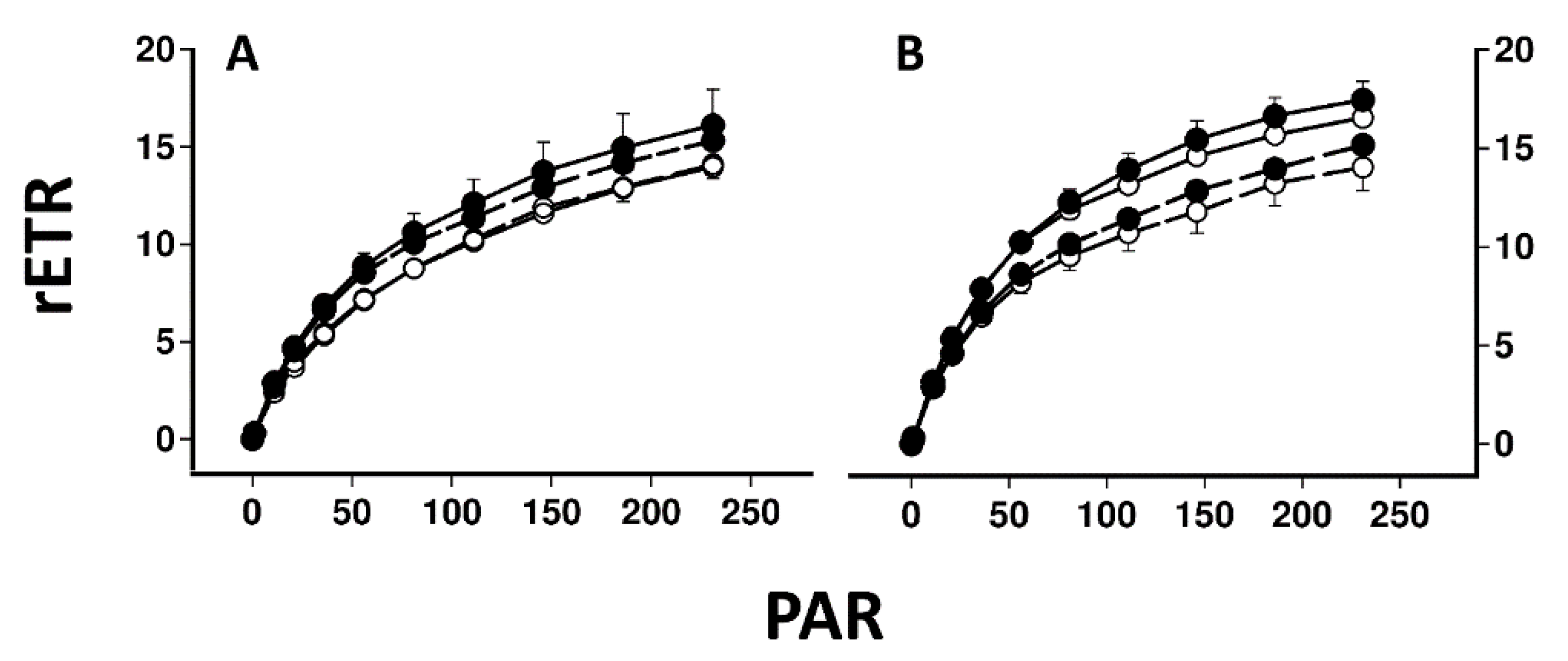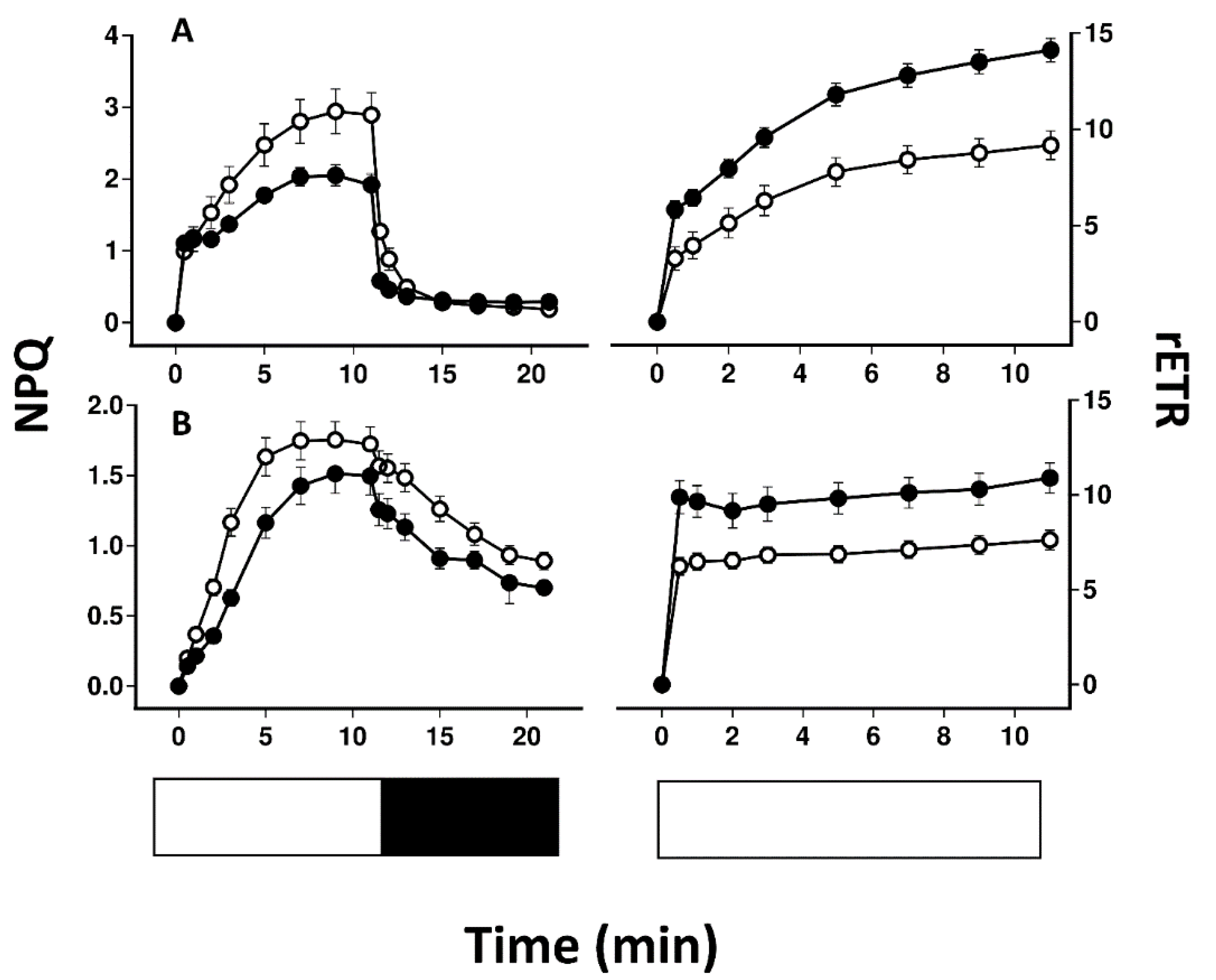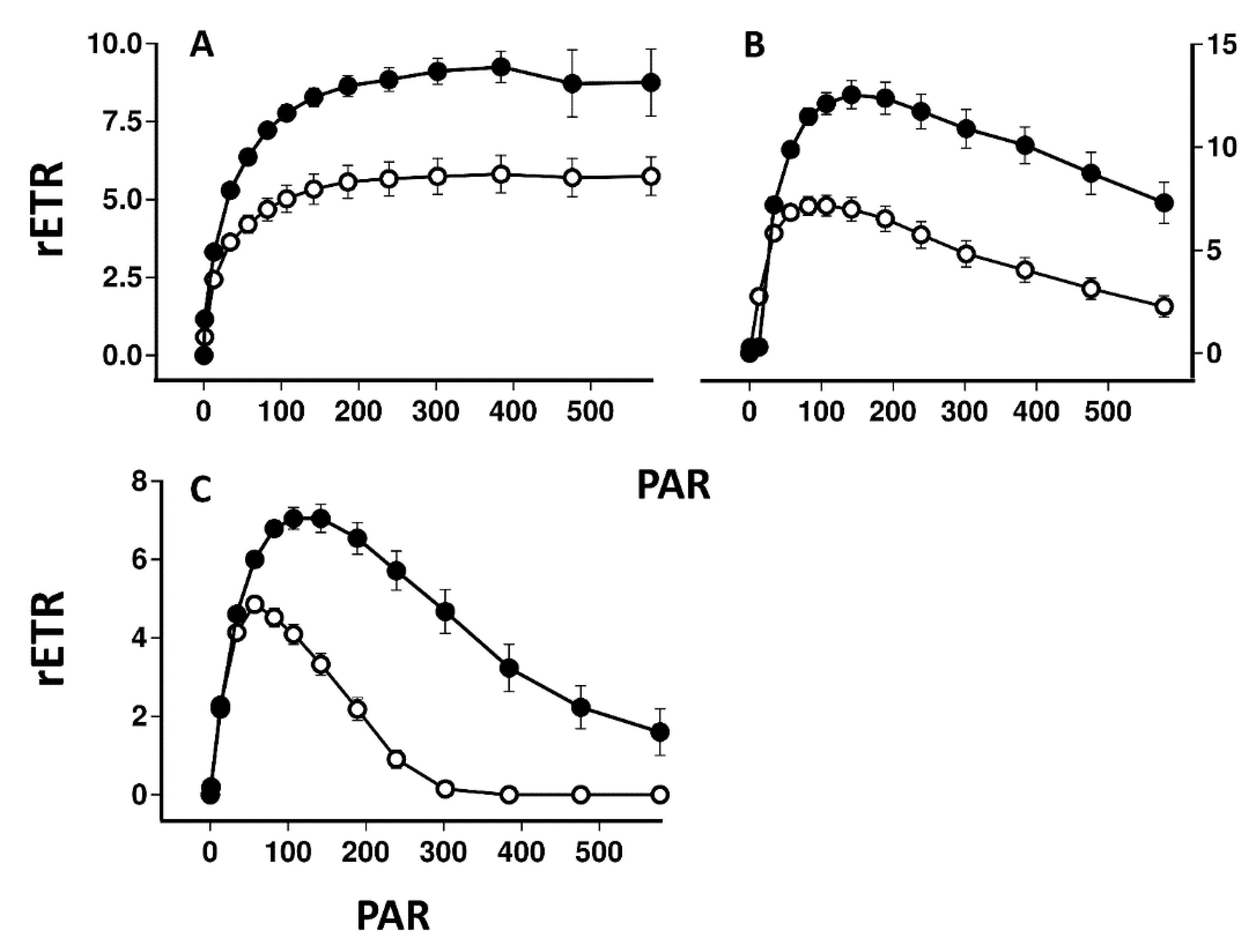Melanisation in Boreal Lichens Is Accompanied by Variable Changes in Non-Photochemical Quenching
Abstract
1. Introduction
2. Results
3. Discussion
3.1. NPQ Can Be Measured through a Melanised Cortex
3.2. Photobionts from the Top of the Photobiont Layer Display Relative Sun Characteristics
3.3. Melanised Thalli Display Different NPQ Responses Compared with Pale Thalli
4. Materials and Methods
4.1. Lichen Material
4.2. Chlorophyll Fluorescence
4.3. Statistical Analysis
5. Conclusions
Author Contributions
Funding
Data Availability Statement
Acknowledgments
Conflicts of Interest
References
- Pospíšil, P. Production of reactive oxygen species by photosystem II as a response to light and temperature stress. Front. Plant Sci. 2016, 7, 1950. [Google Scholar] [CrossRef] [PubMed]
- Zavafer, A.; Mancilla, C. Concepts of photochemical damage of Photosystem II and the role of excessive excitation. J. Photochem. Photobiol. C Photochem. Rev. 2021, 47, 100421. [Google Scholar] [CrossRef]
- Foyer, C.H. Reactive oxygen species, oxidative signaling and the regulation of photosynthesis. Environ. Exp. Bot. 2018, 154, 134–142. [Google Scholar] [CrossRef] [PubMed]
- Beckett, R.P.; Minibayeva, F.V.; Solhaug, K.A.; Roach, T. Photoprotection in lichens: Adaptations of photobionts to high light. Lichenologist 2021, 53, 21–33. [Google Scholar] [CrossRef]
- Gilmore, A.M. Excess light stress: Probing excitation dissipation mechanisms through global analysis of time- and wavelength-resolved chlorophyll a fluorescence. In Chlorophyll a Fluorescence: A Signature of Photosynthesis. Advances in Photosynthesis and Respiration; Papageorgiou, G.C., Govindjee, Eds.; Springer: Dordrecht, Germany, 2004; Volume 19, pp. 555–581. ISBN 978-1-4020-3218-9. [Google Scholar]
- Liu, J.; Lu, Y.; Hau, W.; Last, R.L. A new light on photosystem II maintenance in oxygenic photosynthesis. Front. Plant Sci. 2019, 10, 975. [Google Scholar] [CrossRef] [PubMed]
- Demmig-Adams, B.; Stewart, J.J.; López-Pozo, M.; Polutchko, S.K.; Adams, W.W. Zeaxanthin, a molecule for photoprotection in many different environments. Molecules 2020, 25, 5825. [Google Scholar] [CrossRef] [PubMed]
- Alter, P.; Dreissen, A.; Luo, F.L.; Matsubara, S. Acclimatory responses of Arabidopsis to fluctuating light environment: Comparison of different sunfleck regimes and accessions. Photosyn. Res. 2012, 113, 221–237. [Google Scholar] [CrossRef]
- Beckett, R.P.; Minibayeva, F.V.; Mkhize, K.W.G. Shade lichens are characterized by rapid relaxation of non-photochemical quenching on transition to darkness. Lichenologist 2021, 53, 409–414. [Google Scholar] [CrossRef]
- Mkhize, K.G.W.; Minibayeva, F.V.; Beckett, R.P. Adaptions of photosynthesis in sun and shade in populations of some Afromontane lichens. Lichenologist 2022, in press. [Google Scholar] [CrossRef]
- Shi, Y.; Ke, X.; Yang, X.; Liu, Y.; Hou, X. Plants response to light stress. J. Genet. Genom. 2022, in press. [Google Scholar] [CrossRef]
- Anderson, J.M.; Chow, W.S.; Goodchild, D.J. Thylakoid membrane organization in sun shade acclimation. Aust. J. Plant Phys. 1988, 15, 11–26. [Google Scholar] [CrossRef]
- Mafole, T.C.; Solhaug, K.A.; Minibayeva, F.V.; Beckett, R.P. Occurrence and possible roles of melanic pigments in lichenized ascomycetes. Fung. Biol. Rev. 2019, 33, 159–165. [Google Scholar] [CrossRef]
- Gauslaa, Y.; Solhaug, K.A. Fungal melanins as a sun screen for symbiotic green algae in the lichen Lobaria pulmonaria. Oecologia 2001, 126, 462–471. [Google Scholar] [CrossRef]
- Mafole, T.C.; Solhaug, K.A.; Minibayeva, F.V.; Beckett, R.P. Tolerance to photoinhibition within a lichen species is higher in melanised thalli. Photosynthetica 2019, 57, 96–102. [Google Scholar] [CrossRef]
- Beckett, R.P.; Solhaug, K.A.; Gauslaa, Y.; Minibayeva, F.V. Improved photoprotection in melanised lichens is a result of fungal solar radiation screening rather than photobiont acclimation. Lichenologist 2019, 51, 483–491. [Google Scholar] [CrossRef]
- Gauslaa, Y.; Goward, T. Melanic pigments and canopy-specific elemental concentration shape growth rates of the lichen Lobaria pulmonaria in unmanaged mixed forest. Fung. Ecol. 2020, 47, 100984. [Google Scholar] [CrossRef]
- Bilger, W.; Schreiber, U.; Bock, M. Determination of the quantum efficiency of photosystem II and of non-photochemical quenching of chlorophyll fluorescence in the field. Oecologia 1995, 102, 425–432. [Google Scholar] [CrossRef]
- Terashima, I.; Ooeda, H.; Fujita, T.; Oguchi, R. Light environment within a leaf. II. Progress in the past one-third century. J. Plant Res. 2016, 129, 353–363. [Google Scholar] [CrossRef]
- Buffoni Hall, R.S.; Bornman, J.F.; Björn, L.O. UV-induced changes in pigment content and light penetration in the fruticose lichen Cladonia arbuscula ssp. mitis. J. Photochem. Photobiol. B Biol. 2002, 66, 13–20. [Google Scholar] [CrossRef]
- Wu, L.; Zhang, G.K.; Lan, S.B.; Zhang, D.L.; Hu, C.X. Longitudinal photosynthetic gradient in crust lichens’ thalli. Micro. Ecol. 2014, 67, 888–896. [Google Scholar] [CrossRef]
- Karabourniotis, G.; Liakopoulos, G.; Bresta, P.; Nikolopoulos, D. The optical properties of leaf structural elements and their contribution to photosynthetic performance and photoprotection. Plants 2021, 10, 1455. [Google Scholar] [CrossRef]
- Terashima, I.; Inoue, Y. Comparative photosynthetic properties of palisade tissue chloroplasts and spongy tissue chloroplasts of Camellia japonica L.: Functional adjustment of the photosynthetic apparatus to light environment within a leaf. Plant Cell Physiol. 1984, 25, 555–563. [Google Scholar] [CrossRef]
- Terashima, I.; Inoue, Y. Palisade tissue chloroplasts and spongy tissue chloroplasts in spinach: Biochemical and ultrastructural differences. Plant Cell Physiol. 1985, 26, 63–75. [Google Scholar] [CrossRef]
- Terashima, I.; Inoue, Y. Vertical gradient in photosynthetic properties of spinach chloroplasts dependent on intra-leaf light environment. Plant Cell Physiol. 1985, 26, 781–785. [Google Scholar] [CrossRef]
- Peguero-Pina, J.J.; Gil-Pelegrin, E.; Morales, F. Photosystem II efficiency of the palisade and spongy mesophyll in Quercus coccifera using adaxial/abaxial illumination and excitation light sources with wavelengths varying in penetration into the leaf tissue. Photosyn. Res. 2009, 99, 49–61. [Google Scholar] [CrossRef]
- Hooijmaijers, C.A.M.; Gould, K.S. Photoprotective pigments in red and green gametophytes of two New Zealand liverworts. N. Z. J. Bot. 2007, 45, 451–461. [Google Scholar] [CrossRef]
- Hatier, J.-H.B.; Clearwater, M.J.; Gould, K.S. The functional significance of black-pigmented leaves: Photosynthesis, photoprotection and productivity in Ophiopogon planiscapus ‘Nigrescens’. PLoS ONE 2002, 8, e67850. [Google Scholar] [CrossRef]
- Liakopoulos, G.; Nikolopoulos, D.; Klouvatou, A.; Vekkos, K.-A.; Manetas, Y.; Karabourniotis, G. The photoprotective role of epidermal anthocyanins and surface pubescence in young leaves of grapevine (Vitis vinifera). Ann. Bot. 2006, 98, 257–265. [Google Scholar] [CrossRef]
- Lo Piccolo, E.; Landi, M.; Pellegrini, E.; Agati, G.; Giordano, C.; Giordani, T.; Lorenzini, G.; Malorgio, F.; Massai, R.; Nali, C.; et al. Multiple consequences induced by epidermally-located anthocyanins in young, mature and senescent leaves of Prunus. Front. Plant Sci. 2016, 9, 917. [Google Scholar] [CrossRef]
- Gould, K.Z.; Vogelmann, T.C.; Han, T.; Clearwater, M.J. Profiles of photosynthesis within red and green leaves of Quintinia serrata. Physiol. Plant. 2002, 116, 127–133. [Google Scholar] [CrossRef] [PubMed]
- Gong, W.-C.; Liu, Y.-H.; Wang, C.-M.; Chen, Y.-Q.; Martin, K.; Meng, L.-Z. Why are there so many plant species that transiently flush young leaves red in the tropics? Front. Plant Sci. 2020, 11, 83. [Google Scholar] [CrossRef] [PubMed]





| Effect | Degrees of Freedom for NPQ | Lobaria NPQ | Crocodia NPQ | Degrees of Freedom for ETR | Lobaria rETR | Crocodia rETR |
|---|---|---|---|---|---|---|
| Melanisation (M) | 1 | * | *** | 1 | *** | 0.202 |
| Position (P) | 1 | 0.206 | * | 1 | 0.057 | * |
| M x P | 1 | 0.081 | 0.337 | 1 | 0.163 | 0.312 |
| Time (T) | 15 | *** | *** | 7 | *** | *** |
| T x C | 15 | *** | *** | 7 | *** | ** |
| T x P | 15 | *** | *** | 7 | *** | *** |
| T x C x P | 15 | *** | 0.059 | 7 | 0.411 | *** |
Publisher’s Note: MDPI stays neutral with regard to jurisdictional claims in published maps and institutional affiliations. |
© 2022 by the authors. Licensee MDPI, Basel, Switzerland. This article is an open access article distributed under the terms and conditions of the Creative Commons Attribution (CC BY) license (https://creativecommons.org/licenses/by/4.0/).
Share and Cite
Ndhlovu, N.T.; Solhaug, K.A.; Minibayeva, F.; Beckett, R.P. Melanisation in Boreal Lichens Is Accompanied by Variable Changes in Non-Photochemical Quenching. Plants 2022, 11, 2726. https://doi.org/10.3390/plants11202726
Ndhlovu NT, Solhaug KA, Minibayeva F, Beckett RP. Melanisation in Boreal Lichens Is Accompanied by Variable Changes in Non-Photochemical Quenching. Plants. 2022; 11(20):2726. https://doi.org/10.3390/plants11202726
Chicago/Turabian StyleNdhlovu, Nqobile Truelove, Knut Asbjørn Solhaug, Farida Minibayeva, and Richard Peter Beckett. 2022. "Melanisation in Boreal Lichens Is Accompanied by Variable Changes in Non-Photochemical Quenching" Plants 11, no. 20: 2726. https://doi.org/10.3390/plants11202726
APA StyleNdhlovu, N. T., Solhaug, K. A., Minibayeva, F., & Beckett, R. P. (2022). Melanisation in Boreal Lichens Is Accompanied by Variable Changes in Non-Photochemical Quenching. Plants, 11(20), 2726. https://doi.org/10.3390/plants11202726







